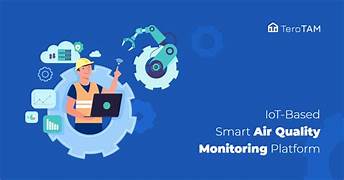The Potential of AI in Improving Air Quality Monitoring
Air pollution is one of the most pressing environmental challenges of our time, with significant implications for human health, climate change, and ecosystems. Monitoring air quality is essential for understanding the extent of pollution, formulating effective policies, and ensuring the well-being of communities. Traditional methods of air quality monitoring, while useful, often fall short in providing real-time, accurate, and comprehensive data. This is where Artificial Intelligence (AI) comes into play. AI has the potential to revolutionize air quality monitoring by enabling more precise measurements, predictive analytics, and better-informed decision-making. In this article, we explore the role AI can play in improving air quality monitoring, its applications, benefits, and challenges.
The Importance of Air Quality Monitoring
Air quality monitoring is crucial for assessing the concentration of pollutants in the atmosphere, such as particulate matter (PM2.5 and PM10), nitrogen dioxide (NO2), sulfur dioxide (SO2), ozone (O3), carbon monoxide (CO), and volatile organic compounds (VOCs). These pollutants can have severe health consequences, including respiratory and cardiovascular diseases, lung cancer, and premature death. Poor air quality also exacerbates climate change, affecting weather patterns, and contributes to the deterioration of ecosystems.
The ability to monitor air quality in real-time helps governments, environmental agencies, industries, and the public understand pollution levels and take appropriate actions. This includes issuing health advisories, enforcing regulations on emissions, and identifying areas that require intervention or policy changes. Traditional air quality monitoring methods, such as stationary sensors and manual data collection, have limitations in terms of coverage, frequency, and accuracy. This is where AI can offer significant improvements.
The Role of AI in Air Quality Monitoring
AI can enhance air quality monitoring in several ways, offering solutions that are more efficient, scalable, and capable of delivering real-time insights. Here’s how AI can contribute to the improvement of air quality monitoring:
1. Enhanced Data Collection
Traditional air quality monitoring relies on a limited number of stationary monitoring stations, which may not cover the entire geographical area. These stations are often expensive to install and maintain, limiting the scope of monitoring. AI, combined with IoT (Internet of Things) devices, can significantly expand the reach of air quality monitoring. Low-cost sensors and devices can be deployed in various locations, providing data from a wide array of sources.
These sensors can capture real-time data on pollutants from multiple points across cities, urban areas, and even remote locations. AI algorithms process the data from these sensors, ensuring that it is accurate and meaningful. This approach leads to more granular, localized data, improving the overall coverage of air quality monitoring.
For example, air quality monitoring systems in smart cities use AI to collect data from a network of sensors embedded in various locations, such as traffic intersections, residential areas, and industrial zones. This extensive network of sensors allows for continuous monitoring of air quality at a much higher resolution compared to traditional methods.
2. Predictive Analytics and Forecasting
One of the most powerful applications of AI in air quality monitoring is its ability to predict future air quality trends and forecast pollution levels. By analyzing historical data, weather patterns, traffic volumes, and industrial activities, AI models can forecast air quality levels for different regions and time periods. These predictions can be used to take proactive measures, such as issuing health warnings or adjusting industrial operations to minimize pollution during high-risk periods.
Machine learning algorithms are particularly effective at identifying patterns and correlations that may not be immediately apparent to humans. For example, AI can analyze the relationship between weather conditions (like temperature, wind speed, and humidity) and pollution levels, helping predict when air quality will deteriorate in specific areas. These predictions can be used to develop early-warning systems that help protect public health.
3. Real-Time Monitoring and Immediate Alerts
AI-powered air quality monitoring systems can provide real-time data and immediate alerts when pollution levels exceed safe thresholds. This is crucial in mitigating the health risks associated with exposure to high levels of air pollution. AI can continuously analyze data from multiple sources, such as sensors, satellites, and weather stations, to detect sudden spikes in pollutant concentrations.
For example, if a monitoring system detects elevated levels of particulate matter (PM2.5) in a particular area, it can automatically send alerts to local authorities, environmental agencies, and the public. This allows for swift actions, such as issuing health advisories, rerouting traffic, or shutting down industrial operations, to minimize the impact of pollution on human health.
In addition, AI can integrate data from various sources, including social media, to gather public reports on air quality and cross-reference them with sensor data. This enhances the accuracy of real-time monitoring and improves the response time to pollution events.
4. Identifying Pollution Sources
AI can also play a crucial role in identifying the sources of pollution. Traditional air quality monitoring methods often struggle to pinpoint the exact origins of pollutants, which can be critical for formulating effective regulatory measures. AI models can analyze data from multiple sources to trace pollution back to its source, whether it be traffic emissions, industrial activities, or natural sources like wildfires.
By using machine learning techniques, AI can analyze patterns in air quality data and correlate them with other factors, such as traffic patterns, industrial emissions, or construction activities. This helps identify the main contributors to air pollution and informs targeted interventions. For example, AI might identify that a particular intersection experiences higher pollution levels due to heavy traffic, prompting authorities to consider measures such as congestion pricing or improved public transportation options.
5. Improving Air Quality Models
AI can enhance the accuracy of air quality models by incorporating a wide range of variables and refining predictive capabilities. Traditional air quality models are often based on simplified assumptions and can struggle to account for the complexity of urban environments, with their dynamic traffic patterns, fluctuating industrial emissions, and varying weather conditions.
AI can process vast amounts of data and integrate real-time inputs to create more accurate and reliable air quality models. These models can be used to simulate the impact of different pollution control measures, such as changes in transportation policies, industrial regulations, or green infrastructure. This helps policymakers make better-informed decisions about how to reduce pollution and improve air quality.
6. Personalized Health Recommendations
AI can also improve public health by providing personalized recommendations based on air quality data. Individuals with respiratory conditions, such as asthma or COPD, can benefit from AI-driven applications that monitor local air quality and offer personalized advice. For example, an AI-powered mobile app can alert users about high pollution levels in their area and suggest actions such as staying indoors, using air purifiers, or wearing masks.
By analyzing personal health data in conjunction with air quality data, AI can provide tailored advice that helps individuals protect their health. This is particularly important for vulnerable populations, such as children, the elderly, and those with pre-existing health conditions, who are more susceptible to the harmful effects of air pollution.
Benefits of AI in Air Quality Monitoring
The integration of AI into air quality monitoring offers numerous benefits:
- Cost-Effective Monitoring: AI enables the use of low-cost sensors and devices, reducing the cost of deploying and maintaining air quality monitoring systems. This makes it possible to monitor air quality in a wider range of locations.
- Real-Time Insights: AI can provide continuous, real-time monitoring, offering immediate insights into air quality and allowing for timely interventions to protect public health.
- Better Decision-Making: AI’s predictive analytics and forecasting capabilities help policymakers, industries, and environmental agencies make data-driven decisions to improve air quality and minimize pollution.
- Personalized Health Protection: AI-powered apps and systems can offer personalized recommendations to individuals based on air quality data, improving public health and well-being.
- Increased Accuracy: AI models can process vast amounts of data from multiple sources, improving the accuracy and reliability of air quality predictions and pollution source identification.
Challenges and Considerations
Despite its potential, there are several challenges to using AI in air quality monitoring:
- Data Privacy: Collecting and analyzing data from various sources, including personal health data, raises concerns about data privacy and security.
- Accuracy of Sensors: The accuracy of low-cost sensors used in AI-powered monitoring systems can vary, which may impact the reliability of the data collected.
- Interoperability: AI-powered air quality monitoring systems need to integrate data from various sources, such as sensors, satellites, and weather stations. Ensuring interoperability between these systems is a key challenge.
- Regulatory Frameworks: The use of AI in air quality monitoring requires robust regulatory frameworks to ensure data accuracy, transparency, and accountability.
Conclusion
AI has the potential to significantly improve air quality monitoring by providing real-time data, predictive analytics, and better decision-making capabilities. By leveraging AI technologies, governments, industries, and individuals can gain deeper insights into pollution levels, identify sources of pollution, and take proactive steps to reduce exposure. While there are challenges to overcome, the benefits of AI in air quality monitoring are immense, offering a more sustainable and health-conscious future for urban environments and beyond.


